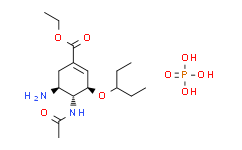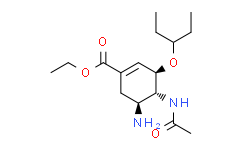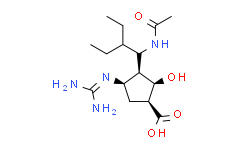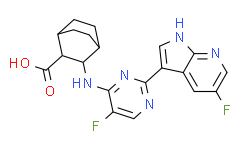| 中文名称: | 磷酸奥司他韦 促销 | ||||
|---|---|---|---|---|---|
| 英文名称: | Oseltamivir phosphate | ||||
| 别名: | 磷酸奥司他韦 ethyl (3R,4R,5S)-4-acetamido-5-amino-3-pentan-3-yloxycyclohexene-1-carboxylate;phosphoric acid | ||||
| CAS No: | 204255-11-8 | 分子式: | C16H31N2O8P | 分子量: | 410.40 |
| CAS No: | 204255-11-8 | ||||
| 分子式: | C16H31N2O8P | ||||
| 分子量: | 410.40 | ||||
基本信息
|
产品编号:O10128 |
|||||
|
产品名称:Oseltamivir phosphate |
|||||
|
CAS: |
204255-11-8 |
储存条件 |
粉末 |
2-8℃ |
四年 |
|
|
|
||||
|
分子式: |
溶于液体 |
-80℃ |
两年 |
||
|
分子量 |
410.40 |
-20℃ |
一个月 |
||
|
化学名: |
ethyl (3R,4R,5S)-4-acetamido-5-amino-3-(pentan-3-yloxy)cyclohex-1-ene-1-carboxylate phosphate |
||||
|
Solubility (25°C) |
体外 |
DMSO |
82mg/mL warmed with 50ºC water bath (199.8mM) |
||
|
Ethanol |
Insoluble |
||||
|
Water |
Insoluble |
||||
|
体内 |
现配现用 |
|
|||
|
<1mg/ml表示微溶或不溶。 |
|||||
|
普西唐提供的所有化合物浓度为内部测试所得,实际溶液度可能与公布值有所偏差,属于正常的批间细微差异现象。 |
|||||
|
请根据产品在不同溶剂中的溶解度选择合适的溶剂配制储备液;⼀旦配成溶液,请分装保存,避免反复冻融造成的产品失效。 |
|||||
制备储备液
|
浓度
溶液体积 质量 |
1mg |
5mg |
10mg |
|
1mM |
2.4366mL |
12.1832mL |
24.3665mL |
|
5mM |
0.4873mL |
2.4366mL |
4.8733mL |
|
10mM |
0.2437mL |
1.2183mL |
2.4366mL |
|
50mM |
0.0487mL |
0.2437mL |
0.4873mL |
生物活性
|
产品描述 |
一种神经氨酸酶抑制剂。 |
|
靶点/IC50 |
Neuraminidase |
|
体外研究 |
Oseltamivir phosphate (OP) is a prodrug that is readily absorbed from the gastrointestinal tract after oral administration and is extensively converted predominantly by hepatic esterases to Oseltamivir carboxylate (OC). Oseltamivir phosphate is a widely used anti-influenza sialidase inhibitor. The metabolic activity of CMA07 and CMT-U27 cell lines is significantly decreased with 305μM Oseltamivir phosphate treatment (p=0.005 and p<0.0001 respectively) using One Way ANOVA testes. In contrast, no statistically significant alterations are observed with 0.305μM (p=0.9781), 3.05μM (p=0.7436) and 30.5μM(p=0.9623) of Oseltamivir phosphate treatments when compare with control cells. Finally, to assess the effect of Oseltamivir phosphate on CMA07 and CMT-U27 programmed cell death, and given that 305μM Oseltamivir phosphate treatment impaired cell metabolic activity, a programmed cell death measurement is performed with the TUNEL assay. Twenty-four hour Oseltamivir phosphate treatment, specifically at 305μM, significantly increases CMA07 (p=0.001) and CMT-U27(p=0.0002) DNA fragmentation, suggesting promotion of programmed cell death, when compare with lower Oseltamivir concentrations, or with PBS. |
|
体内研究 |
Oseltamivir phosphate-treated mice present significantly more inflammatory infiltrate in primary tumors (p=0.01). Ki-67 antigen and caspase-3 protein are used to assess CMT-U27 xenograft tumor cell proliferation and apoptosis respectively.Virtually no differences are found in Ki-67 and caspase 3 (p=0.2) expression between Oseltamivir-treated and non-treated mice. |
推荐实验方法(仅供参考)
|
细胞实验: |
|
|
Cell Assay |
CMA07 and CMT-U27 cells are cultured in 24-well plates in triplicate for each condition: 0.305μM, 3.05μM, 30.5μM and 305μM Oseltamivir phosphate and PBS is used as control. Cells are counted every day for 7 days in a Neubauer’s chamber in a 1:2 dilution of cells in 0.4% trypan blue and cell count is done using the volume conversion factor for 1 mm3, which is 1×104.This assay is repeated 3 times and growth curves are traced. |
|
动物实验: |
|
|
Animal Administration |
Mice Female NIH(S)II-nu/nu nude mice, aged 4-6 weeks, are orthotopically inoculated with 1×106 viable CMT-U27 canine breast cancer cells in the mammary fat pad using a 25 gauge needle. A total of 8 mice are inoculated. When nodules reached a volume of approximately 500 mm3, mice (n=8) are randomized and divided into control group (n=4) and treatment group(n=4).The animals receive intraperitoneally (IP) dailly either 100μL of PBS (control group) or 100mg/Kg of Oseltamivir phosphate, diluted in PBS (treatment group) until time of death. Tumor size is measured using calipers, and tumor volume(mm3) is estimated by width×length×height. |
本计算器可帮助您计算出特定溶液中溶质的质量、溶液浓度和体积之间的关系,公式为:
质量 (g) = 浓度 (mol/L) x 体积 (L) x 分子量 (g/mol)
摩尔浓度计算公式
用本工具协助配置特定浓度的溶液,使用的计算公式为:
开始浓度 x 开始体积 = 最终浓度 x 最终体积
稀释公式
稀释公式一般简略地表示为:C1V1 = C2V2 ( 输入 输出 )












